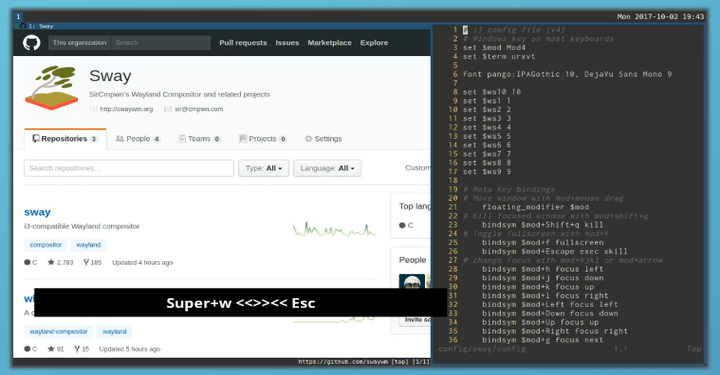Sway – A Tiling Wayland i3-Compatible Compositor



I have covered window tiling editors/managers previously with apps like herbstluftwm and Tilix so check them out if you haven’t already.
Sway is a free and open source tiling Wayland compositor that is compatible with the i3 window manager, uses the same configuration syntax, and works with most of the software designed for i3.
Sway makes use of all the available space on your screen and automatically adjusts window sizes as you open more apps and you can navigate between apps with your keyboard.
App windows can be arranged horizontally, vertically, stacked, or tabbed and you can change their size as well as split windows into containers of several windows all without touching your mouse. You could, however, use your mouse to rearrange windows and even take windows out of the tiling grid and manipulate them.44
-

- Login or register to post comments
 Printer-friendly version
Printer-friendly version- 2776 reads
 PDF version
PDF version
More in Tux Machines
- Highlights
- Front Page
- Latest Headlines
- Archive
- Recent comments
- All-Time Popular Stories
- Hot Topics
- New Members
digiKam 7.7.0 is released
After three months of active maintenance and another bug triage, the digiKam team is proud to present version 7.7.0 of its open source digital photo manager. See below the list of most important features coming with this release.
|
Dilution and Misuse of the "Linux" Brand
|
Samsung, Red Hat to Work on Linux Drivers for Future Tech
The metaverse is expected to uproot system design as we know it, and Samsung is one of many hardware vendors re-imagining data center infrastructure in preparation for a parallel 3D world.
Samsung is working on new memory technologies that provide faster bandwidth inside hardware for data to travel between CPUs, storage and other computing resources. The company also announced it was partnering with Red Hat to ensure these technologies have Linux compatibility.
|
today's howtos
|









.svg_.png)
 Content (where original) is available under CC-BY-SA, copyrighted by original author/s.
Content (where original) is available under CC-BY-SA, copyrighted by original author/s.

The Greenfield Wayland Compositor
The Greenfield Wayland Compositor Can Now Run Apps Directly In Your Web Browser